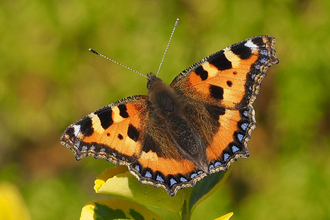Over the last couple of years when the weather has been lovely, I've left my door open a little later than usual. On two such occasions, a male glow worm has flown in. I have to admit to a new level of excitement! It’s hard work to try and find glow worms these days so to have one in my house was incredible. What’s even more exciting is that it probably means that there’s a glow worm population not far away – the males are reluctant fliers so, theoretically, he’d come from relatively close by. Despite lots of searching, however, I've yet to find this elusive population!
Glowing, glowing, gone...
Female glow worm by Wendy Carter

Male glow worm by Wendy Carter
They might be called worms but they're actually beetles (and UK glow worms shouldn't be mistaken for ones like those in New Zealand, which are larvae of gnats). Only the females glow brightly; males and juveniles have the ability to produce a weaker glow but rarely do. The yellow-green glow that they create is called bioluminescence – a chemical reaction – and exists in a number of segments at the base of the abdomen. Flightless females clamber up tall grass stems, lift the bottom of their abdomen into the air and glow to attract a mate…perhaps it was the glow of the light in my house that confused the males that arrived. As well as pesticide use and mismanagement of the places that they live, light pollution could be one reason for their decline – how could a female glow worm possibly compete with street or security lighting?

Glow worm larva by Wendy Carter
Adult glow worms live for just a few weeks and put all their energy into finding a mate and producing the next generation – they don’t even eat. Eating is left to the larvae who can take two to three years before fully maturing. During this time they are voracious snail hunters with toxic bites that paralyse their prey and dissolve its soft body parts. Glow worm larvae have occasionally been spotted riding on the snail’s shell, waiting for the process to complete before drinking the gloopy remains!
Glow worms are widespread across Worcestershire but we think populations are decreasing – they’re certainly much harder to spot these days and in fewer numbers too. Could this be down to the fact that the females stop glowing when they’ve mated and we’re just not seeing them at the right time? Via our Wildlife Sightings form we've had a few records of glow worms in previously unknown locations. So, here’s your challenge! Gardens, bases of hedgerows, railway embankments, canal towpaths, woodland rides – places where the grass is left long until late summer – are all places that you might spot a glowing beetle. To spot a glowing female you’ll need to be out when dusk has fallen and darkness is on its way (they burrow underground during daylight hours to avoid predators). Let your eyes adjust to the light levels and look carefully because they can be easy to miss. If you spot one, take a photo (tricky, I know, sorry) and upload the details to our Wildlife Sightings form so we can add it to the county map.




